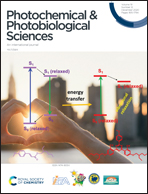Thiophene-phenylquinazoline probe for selective ratiometric fluorescence and visual detection of Fe(iii) and turn-off fluorescence for I− and its applications†
Abstract
A 2,5-bis(4-phenylquinazolin-2-yl)thiophene (BQT) probe is designed, synthesized and explored for selective ratiometric fluorescence and visual detection of Fe3+ and as a turn-off fluorescence probe for I− anion. BQT is colorless and has blue emission in CH3CN solution. BQT selectively complexes with Fe3+, turns its solution from colorless to greenish yellow and enables the ratiometric sensing of Fe3+ with limit of detection (LOD) and limit of quantitation (LOQ) of 2 × 10−8 M and 6.1 × 10−8 M, respectively. Binding constant of BQT with Fe3+ is found to be 4.1 × 10−4 M−1. BQT is also able to sense I− anion present in aqueous solution by selectively turning colorless to yellow and fluorescence quenching with a LOD of 1.7 × 10−7 M and LOQ of 5.2 × 10−7 M. BQT sensing ability is not influenced by the presence of other metal ions and anions in the vicinity. The BQT–Fe3+ complex is thoroughly characterized using MALDI-TOF, NMR and Job's plot. A reversibility experiment with EDTA suggests BQT is a reversible fluorescent chemosensor for Fe3+ ions. The spectroscopic data of BQT and its complexes are employed to construct a field test kit for qualitative analysis and INHIBIT logic gate.



 Please wait while we load your content...
Please wait while we load your content...